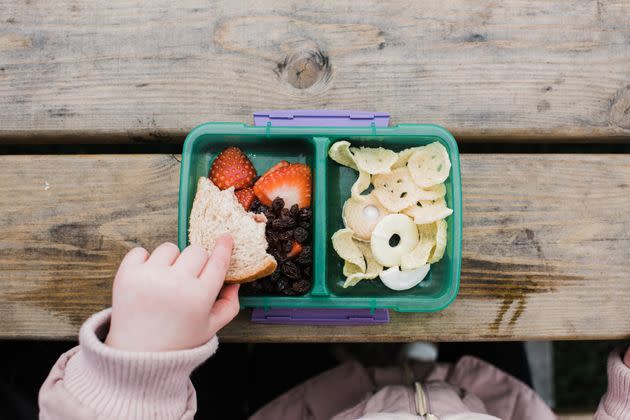These 'Healthy' Lunchbox Faves Are Actually Pretty Sugary – 5 Swaps To Try Instead

(Photo: Cavan Images via Getty Images)
It can be tough being on lunchbox duty. You want to mix things up so your little one doesn’t get bored, but equally for most parents it’s a last-minute sweep of whatever’s in your cupboards and the fridge before you dash out for work.
Often this will mean swiping a cereal bar here, or an oat bar there – the perfect healthy snack to keep them going, you muse.
But new research suggests these are actually some of the worst offenders when it comes to sugar-filled lunchbox staples that parents think are healthy.
Some children’s lunchboxes routinely contain up to 10 teaspoons (40g) of sugar, which is more than double the recommended daily sugar intake for four to six-year-olds, according to research by foodtech company Nick’s in collaboration with paediatric dietician Lucy Upton.
The average UK schoolchild’s lunchbox contains 22.3g of sugar, they said. To compare, a child’s recommended daily sugar intake is 19g for four to six-year-olds, and 24g for seven to 11-year-olds.
According to the research, some of the high-sugar products that most frequently feature in lunchboxes, and are commonly misunderstood to be ‘healthy’ options, are: cereal bars, fruit and nut bars, ‘baked’ or oat-based snack bars, sugar-sweetened yoghurts and smoothies.
Of course, demonising sugar isn’t the way to go about things. We know how hard it can be trying to come up with inventive snacks for little ones to munch on throughout the day. But there are some low-sugar alternatives you can try if you want to shake things up a bit.
Children’s nutritionist Charlotte Stirling-Reed says when it comes to children’s diets, “it’s all about what they are having the majority of the time – not just every now and then”.
So if your child has too much sugar on occasion, “it’s not the end of the world”, she says. “But ideally you don’t want this to be something that happens regularly.”
If you are looking for lower sugar alternatives, mum-of-two Stirling-Reed, who has penned two recipe books on weaning and getting toddlers to eat well, has some ideas.
“When it comes to lunchboxes, it’s often such a challenge to make them simple, nutritious, balanced and something that your little one will eat,” she says.
“Ultimately however, kids like what they are familiar with and it doesn’t take long for new foods to become the ‘norm’, especially if you start when they are young.”
Making snacks in bulk – perhaps over the weekend, and then sticking them in the freezer – can mean you have a stash of things to bung in lunchboxes each morning which should save you some time.
Here are some alternatives you could try:
Crackers and filling – a useful snack that doesn’t rely on sweetness. Fillings could include marmite, cheese or hummus.
Instead of a sugary yogurt, try popping some plain yogurt in a small Tupperware box and adding in chopped fruit to give it that sweetness .
Salad kebab sticks and dips
Energy balls – although you should check your child’s nursery or school policy on nuts before adding these, the nutritionist warns.
Savoury flapjacks
The research put questions to 1,000 UK parents, in order to explore education levels and behaviours surrounding sugar in children’s diets.
It also found 78% of UK parents worry about their children’s sugar intake, but
only 37% of parents feel “very confident” when reading product labels for sugar content information.
This article originally appeared on HuffPost UK and has been updated.

